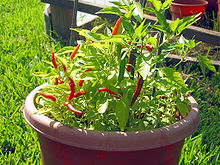African Birdseye
| Piri piri | |
|---|---|

Pili pili peppers (ripe red and unripe green)
|
|
| Genus | Capsicum |
| Species | Capsicum chinense |
| Cultivar | Pili pili |
| Heat |
|
| Scoville scale | 50,000–175,000 SHU |
Piri piri (/ˌpɪriˈpɪri/ PIRR-ee-PIRR-ee; also spelled peri peri or pili pili, also called bird's eye chili), is a cultivar of Capsicum chinense, a chili pepper that grows both wild and as a crop.
It is a small member of the Capsicum genus. It grows in African countries and was taken by the Portuguese to their Indian territories of Gujarat and Goa.
Piri piri is Swahili for "pepper pepper". Other romanizations include pili pili in the Democratic Republic of the Congo or peri peri in Malawi, deriving from the various pronunciations of the word in parts of Bantu languages-speaking Africa. Piri piri is the spelling of the name as used in the Portuguese language, namely in the Portuguese-speaking Mozambican community.
The Oxford Dictionary of English records piri-piri as a foreign word meaning "a very hot sauce made with red chilli peppers" and giving its origin as the Ronga language of southern Mozambique word for "pepper".
Plants are usually very bushy and grow in height to 45–120 cm (18–47 in) with leaves 4–7 cm (1.6–2.8 in) long and 1.3–1.5 cm (0.51–0.59 in) wide. The fruits are generally tapered to a blunt point and measure up to 8–10 cm (3–4 in) long. Immature pod color is green, mature color is bright red or purple. Some varieties of birdseye measure up to 175,000 Scoville heat units.
...
Wikipedia
